| Hydraulics & Pneumatics Limited manufactured a wide
range of industrial and marine hydraulic and pneumatic
equipment, and valves for liquids and gases. The
valves, known as 'Fullway' valves were available in a
wide range of sizes to suit many applications. They
could also be remotely controlled and so were suitable
for automatic systems.
They had many advantages over the competition. They
offered a smooth full-way passage that avoided the
possibility of turbulence, and could operate without
leakage, in either direction of flow. They required no
lubrication, which could contaminate the media, had no
wearing surfaces, so they were reliable for long
periods, and needed little attention. The smaller valves
could operate at pressures of up to 5,000p.s.i. They
were suitable for viscous or gritty liquids, or high
vacuum, and could work over the wide temperature range
of -80oF to +400oF. |
|
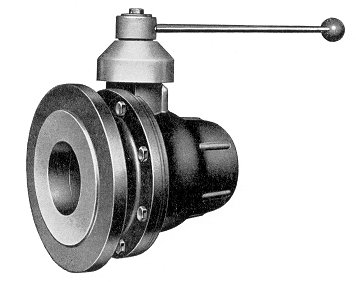
An SFFK ball valve. |
SFFK ball valves were fitted with a spherical plug
shut-off unit and provided a straight through circular
passage with excellent flow characteristics.
Turbulence was eliminated because the medium passed,
as if through a smooth pipe, and a leak-tight seal was
given in either direction of flow.
The valve was fitted with 90o rotational
stops and consisted of a forged steel body with an
anodised aluminium alloy spherical plug, and Perbunan
seals. |
| BK ball valves, like the SFFK valves, had the same
excellent flow characteristics and freedom from
turbulence. Sealing of the spherical plug was ensured by
sealing rings under pressure, which gave a leak-tight
seal in either direction of flow. The body and
connections were of rust-proofed steel, the spherical
plug was made of brass, and the seals were made of
Perbunan. |
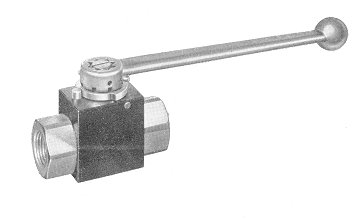
A BK ball valve. |
|
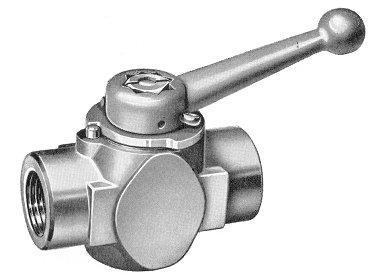
A low pressure NK ball valve. |
The NK valve was fitted with a spherical plug
shut off unit offering excellent flow
characteristics and freedom from turbulence. Sealing
was ensured by an annular sealing ring whose contact
pressure increased as the operating pressure rose.
This provided a tight seal in both directions of
flow. The valve operated over a rotation of 90o.
The body and interior parts were made of brass and
the seals were of Perbunan or Polyamide. |
| Like the other valves in the range the MK was fitted
with a spherical plug shut off unit and so had the same
flow characteristics and freedom from turbulence as the
other models. Sealing of the spherical plug was ensured
by sealing rings under pressure, which gave a leak-tight
seal in either direction of flow. The spherical plug
had a hard chromium plated surface and the seals were
made of Perbunan, Polyamide or Teflon. |
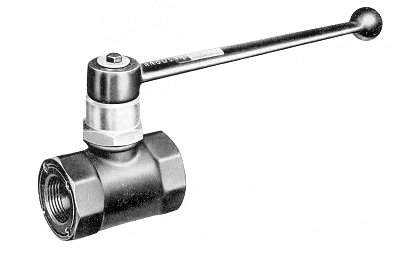
A screwed ball -valve type MK. |
|
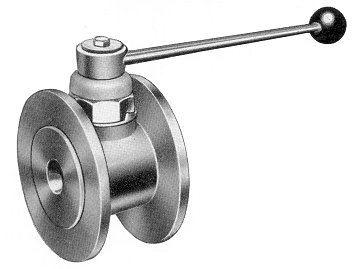
A flanged ball-valve type KFK. |
The valve had the same excellent flow and operating
characteristics as the other models.
The KFK valve was shorter, and mounted between two
large pipe flanges. It could handle very high pressures
of up to 4,250p.s.i.
The internal pipe diameter was between
½ inch and 2 inches. The
body was made of steel and the plug of chromed steel or
chromed cast iron. The seals were of Perbunan,
Polyamide or Teflon. |
| BKM valves were 3 or 4 way valves which provided a
tight seal in all directions of flow. The operating
pressure was up to 4,250p.s.i. depending upon size, but
they were not suitable for use with gases or vacuum.
They had a forged steel, black anodised body, a bronze
annular piston and stainless steel ball-plug. The seal
rings were made of Teflon. |
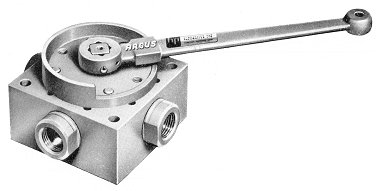
A BKM Multi-Way valve. |
|
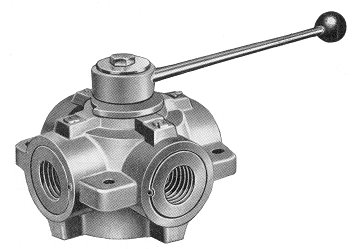
An MW3 3 Way Valve. |
Fullway 3 way valves were fitted with a spherical
plug shut off and control unit, and had 'T' or 'L'
ports. They were ideal for use with oil or water up to a
pressure of 3,550p.s.i. The smaller sizes had a
wrought steel body, whereas the larger models had a
malleable cast iron body. The interior parts were made
of chromium plated brass and the seals were made of
Perbunan or Polyamide. |
| H & P produced their own high pressure seals up to a
diameter of 6 inches. They were originally developed for
the aircraft industry and worked without backing rings
up to a pressure of 5,000p.s.i. They were also suitable
for use in hydraulic systems. Many of the rings were
made of P.T.F.E. although they were available in a range
of materials. |
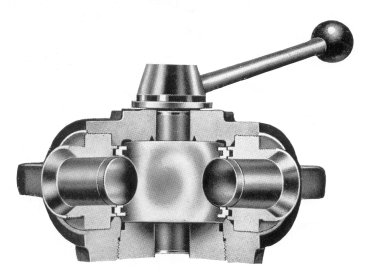
The inner workings of a Fullway
multi-way valve. |
|
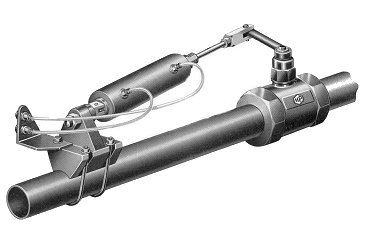
A power operated remote control
for Fullway valves. |
The H & P remote control was designed to operate the
whole range of Fullway valves. It consisted of a
double-acting hydraulic cylinder that was attached to
the pipework by two 'U' bolts.
The distance between the valve and the 'U' bolts could
be adjusted to endure that the valve fully opened and
closed. |
| Several different types of control valve were
produced to operate the remote controls. The one
opposite is a simple hand-operated valve. |
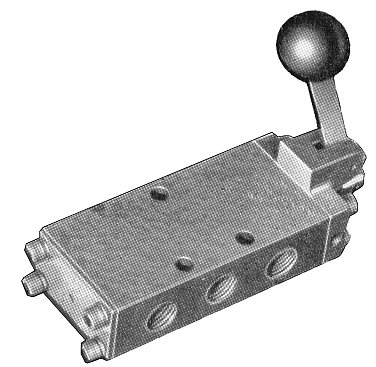 |
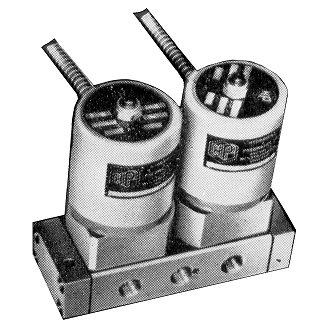 |
More complex or automatic control systems for the
remote controls could use solenoid valves. The
photograph shows a double H & P solenoid operated valve. |
| Speed controls, such as the one opposite were
produced to control the time taken for the remote
control to open or close a valve. |
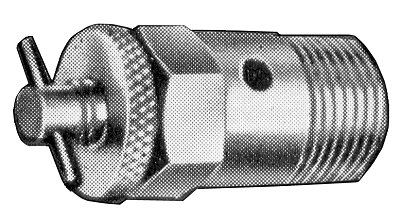 |
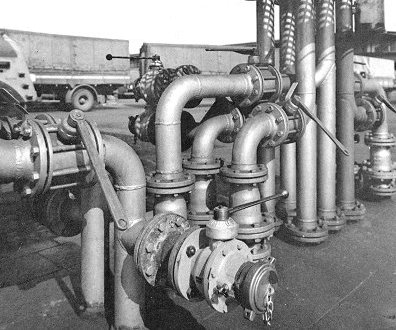
Large diameter Fullway valves in use in a tanker
wagon loading
station. |
|
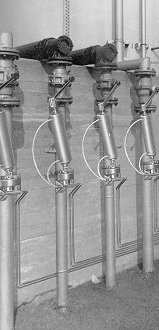
Several remote controls in
operation. |
The Fullway valve system was extremely
sophisticated, and complex systems could easily be
developed. Large installations could be remotely
controlled from a central point, an important
feature that found uses in many industries including
shipping.
|
 |
Read
about H & P's
marine products |
I would like to thank Derek Beddows
for his help in producing this section. |
 |
Return to
the Turner
Manufacturing Co. |
|